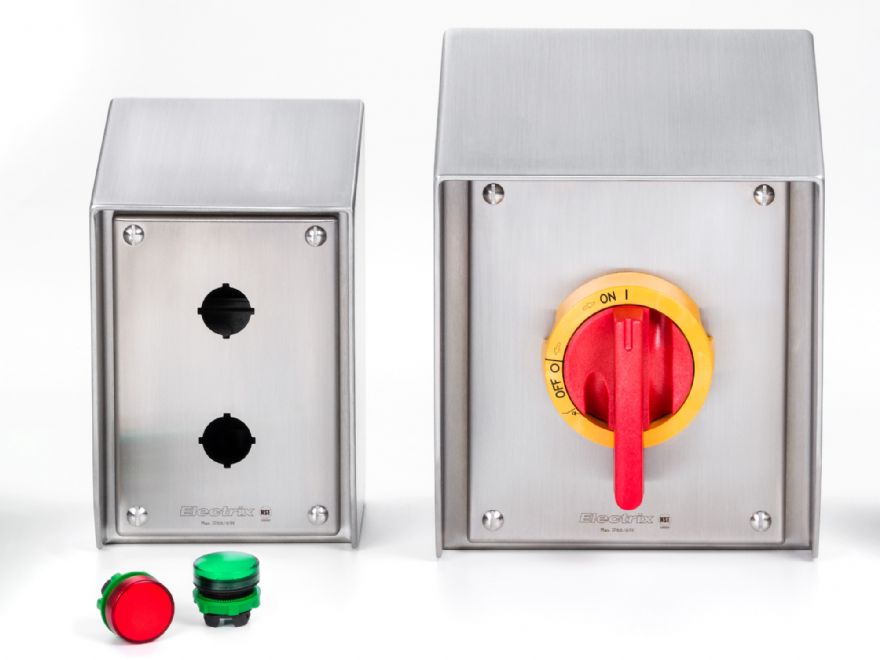 Electric enclosure etching Electrix International Ltd
Electric enclosure etching Electrix International LtdCounty Durham-based
Electrix International Ltd, a leading manufacturer and stockist of stainless steel electrical enclosures and cable management systems, is enjoying the many benefits provided by a new Trumpf TruMark Station 5000 laser-marking system supplied by Luton-based
Trumpf Ltd.
The new machine has replaced a previous foil sticker to provide a fast, permanent way of marking and identifying products without compromising requirements for hygiene or corrosion resistance.
As the market leader for over 35 years, Electrix produces a host of enclosures, trunking systems, conduit solutions and cable tray products at its ISO9001:2015 accredited facility in Bishop Auckland.
The company’s principal differentiators are large stocks and that its products are manufactured exclusively from stainless steel, eliminating the risk of cross contamination from mild steel during the manufacturing processes, making them ideal for use in sectors including food, pharmaceutical, brewing, dairy and soft drinks.
For many years enclosures had been supplied with an expensive Electrix foil sticker proudly mounted on the front to indicate branding. Foil was preferred because it is a clean, metal-detectable material, making it suitable for the industries served by the company.
Stewart Beer, Electrix manufacturing manager, said: “Although the foil sticker is difficult to remove, there is a chance it could come off under extreme pressure from a hot jet wash or when subject to a caustic cleaning solution, for example.”
“This is obviously unlikely for an electrical enclosure, but we were always mindful of this possibility. In addition, to get our products officially certified for safe use within the food industry we approached the NSF [National Sanitation Foundation), who loved the product but indicated that the foil sticker might be an issue.”
Mr Beer added: “We tested a number of laser markers, but the TruMark Station 5000 stood out, not just for its performance in terms of speed and marking colour/tone, but for its user-friendly interface. This latter point became a decisive factor in the purchase decision. We found a number of machines with a good laser head, but they lacked ease of use.”
Since installing the TruMark Station 5000, which is able to accommodate workpieces measuring up to 680 x 500 x 700mm in size, the company has been busy marking products made from either 316 or 304 grade stainless steel in a range of different finishes, including satin and polished. It can be combined with all Trumpf marking lasers.
At Electrix, the method selected is known as laser annealing, which differs from laser engraving and ablation in that no material is removed.
In laser annealing, marking occurs beneath the material’s surface using a precise combination of heat, pulse intensity and speed. When different combinations of these parameters are applied to stainless steel, a variety of tones can be achieved, all of which are permanent.
The process maintains the smooth surface texture of the stainless steel, preventing dirt and grime from collecting in the marks, which is particularly important for Electrix due to the sectors it serves.
Mr Beer continued: “Laser annealing gives us a very clean finish – there is nothing on or under the surface, it just provides a neat black finish that is smooth to the touch.”
Typical batch sizes at Electrix are in the realm of 50-100, which prompted the company to develop its own jig that fits into the bottom of the machine and keeps set-up times to a minimum.

Mr Beer said he took inspiration for the fixture from a standard printer that many people have at home. The mechanism whereby paper is centralised in the feed tray by adjusting just one side tab (the other side comes in automatically) is replicated in the jig that his engineers manufactured in-house.
Products are simply placed into the middle of the fixture, with one slide pushed inwards to provide accurate centralising.
Set-up times are 5-10 seconds maximum, supported by the fact that programs are called-up instantly using a barcode scanner integrated with the laser marker. All products manufactured by Electrix have unique identifiers for product traceability with embedded bar codes.
Mr Beer concluded: “An outline of our logo, our NSF certification and the product’s IP rating are marked in a 5sec cycle. All of our finished goods and many sub-assemblies are marked using the Trumpf machine, with some also including a barcode that directs its customers back to the Web site.
“Furthermore, a number of customers have asked for their own logos to be added to the product using the TruMark.”
Marking systems from Trumpf come in a range of sizes and power classes so that customers can find the optimal device for every task. All lasers are certified to class 1, ensuring they can be used without any additional safety measures.
On-site at Bishop Auckland, further Trumpf machines include a TruLaser 3030 Fiber laser-cutting machine with Liftmaster sorting station and two TruBend 5000 series press brakes — a TruBend 3100X is currently on order.